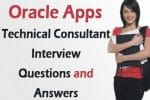Oracle Apps Technical Consultant Interview Questions and Answers
Oracle Apps Technical Consultant understand the coding standards prescribed by Oracle and have a deep understanding of the entire Oracle implementation life cycle. Technical consultants are expected to work on development activities and managing custom application development projects, customization and extension of Oracle Applications. They are often required to act as a trusted technical consultant for customers to select, prepare and support products within their organizations along with technical problem resolution. Following are some frequently asked Oracle Apps Technical Consultant interview questions and answers for your reference. However, you should be prepared with other questions as well.
1 Q: What is ERP?
A: Enterprise Resource Planning (ERP) is business process management software that allows an organization to use a system of integrated applications to manage the business and automate many back office functions related to technology, services and human resources.
2 Q: What is FSG? What are its uses?
A: FSG stands for Financial Statement Generator. It is a powerful report building tool for Oracle. The uses of FSG are – it generates financial reports, defines reports with reusable report objects, design custom financial report to meet specific business needs, print as many reports as needed simultaneously etc.
3 Q:. What are user exits in oracle reports?
A: A User Exit is an API, which provides a way to pass control from Reports Builder to a 3GL program that performs some function, and then returns control to Reports Builder. Using these we can integrate Oracle reports with Oracle apps AOL, and run them as concurrent programs. Following are the user exits available in Oracle reports that make the AOL integration:
FND SRWINIT
FND SRWEXIT
FND FORMAT_CURRENCY
FND FLEXIDVAL
FND FLEXSQL
4 Q: What is the significance of profile option “Node Trust Level” in Oracle Apps?
A: If this profile option is set to a value of external against a server, then it signifies that the specific mid tier is external i.e. it will be exposed to the www. In other words this server is not within the firewall of your client. The idea behind this profile option is to flag such middle tier so that special restrictions can be applied against its security, which means a very restricted set of responsibilities will be available from such middle tier.
5 Q: Does Oracle support partitioning of tables in Oracle Apps?
A: Yes, Oracle does support partitioning of tables in Oracle Applications. There are several implementations that partition on GL_BALANCES. However, your client must buy licenses to if they desire to partition tables. To avoid the cost of licensing you may suggest the clients may decide to permanently close their older GL periods, such that historical records can be archived.
6 Q: What is the difference between Form, function and menu?
A: A menu is a hierarchical arrangement of functions and menus. Each responsibility has a menu assigned to it. A function is a part of an application that is registered under a unique name for the purpose of assigning it to be including it from a menu.
7 Q:. What is TCA (Trading Community Architecture)?
A: Oracle Trading Community Architecture is a data model that allows you to manage complex information about the parties, or customers, who belong to your commercial community, including organizations, locations, and the network of hierarchical relationships among them. This information is maintained in the TCA Registry, which is the single source of trading community information for Oracle E-Business Suite applications.
8 Q:. How do we enable tracing for the document managers?
A: This can be done by setting profile option “Initialization SQL Statement- Custom” against your username before reproducing the issue. The value of this profile will be set so as to enable trace using event 10046, level 12.
9 Q:. What is SYSTEM tablespace and when is it created?
A: Every Oracle database contains a tablespace named SYSTEM, which is automatically created when the database is created. The SYSTEM tablespace always contains the data dictionary tables for the entire database.
10 Q: What is an Oracle View?
A: A view is a virtual table. Every view has a query attached to it. The query is a SELECT statement that identifies the columns and rows of the table the view uses.
11 Q: What are Schema Objects?
A: Schema objects are the logical structures that directly refer to the database’s data. Schema objects include tables, view, sequences, synonyms, indexes, clusters, database triggers, procedures, functions packages and database links.
12 Q: How to define Data Block size?
A: A data block size is specified for each ORACLE database when the database is created. A database users and allocated free database space in ORACLE data blocks. Bock size is specified in INIT.ORA file and can’t be changed latter.
Categories: Job Interview Tags: Consultants, Oracle Apps, Technical Interviews

